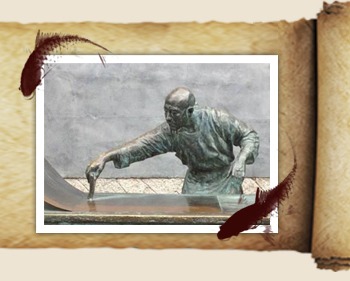

| The beginning of design | Statistical results | Staistical analysis |
Survey on Our Topic
5-1 The Beginning of Design 5.1.1 Design
Since this is a more academic competition, we hope to know the people's level of understanding of the ancient calligraphy. To make data analysis more efficient, we use G single to process the data we got.
5.1.2 Materials: G Survey
In the G survey, there are two parts: basic information and knowledge about ancient calligraphy and painting. By getting the basic information such as education, age, etc., we hope the information would help us with our analysis. On the other hand, we hope to find out the extent of everyone's understanding about the restoration of ancient calligraphy and painting before visiting our website. That way we can further explain to the general public the area they do not understand. Finally, after obtaining the data, we plan to make the data into a simple and easy to understand pie chart and then do our presentation and analysis.
5.1.3 Method
We use advanced science and technology network such as line, Facebook, etc. to share the G survey out. Furthermore, after through friends and teachers' forwarding, it allows more people to help us fill in the questions. As the result, our question ended up with 650 responses, which is far more than what we expect. With such a large data, we will be able to become more accurately and precisely while analyzing the degree of understanding of this study.
5-2 Statistical Results
5.2.1 example question
What is your gender?
How old are you?
What is level of education?
Do you understand what the ancient calligraphy and painting is?
Are you interested in fixing ancient calligraphy?
Do you think there are natural factors that cause the damage in calligraphy?
Do you think these damaged works should be repaired?
Do you think these works should be preserved as it appears?
What should a wearers need to be aware of in order to become profession?
Result
5.2.2 Results
After two months, the audiences continued to give us feedback . Finally, we successfully obtained responses from 657 people. These included people of all ages and educational background, and each person provided valuable survey response . With such a large amount data, we could make an accurate analysis .
5-3 Statistical Analysis According to the survey we formulated, each age group would respond to our research topic. Next, our team will discuss and analyze two aspects. The first is analyzing opinions about whether ancient paintings should be restored. From the chart we can see that over eighty percent thinks that it is necessary for ancient paintings to be restored. Since most people agree on restoration, we will discuss about the degree of understanding about restoration of ancient paintings for people in different age groups. With the increase of age, the knowledge of ancient paintings restoration will also increase, but it would still below 50 percent. Compared to adults, adolescents aged below twenty generally did not have enough knowledge about the restoration of ancient paintings. In other words, if teenagers so unfamiliar with this skill, then restoration technical skills are bound to be lost one day. As a result, the precious history recorded by ancient paintings will be forgotten forever. Overall, Taiwan's current society has only a smattering knowledge of this skill. Analyzing the data based on the previous two results, our team considered it necessary to raise social awareness of the important skill for restoration. More importantly, this indispensible skill should be able to carried forward to future generations.



















